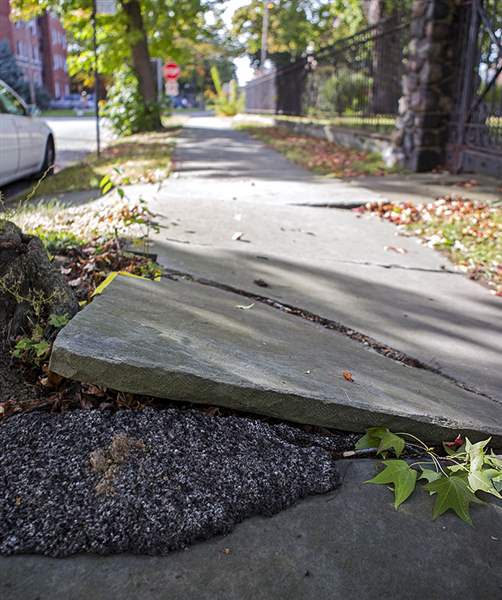
Toledo has no funds for sidewalk repairs
Teen who uses wheelchair travels in street
10/20/2016
Sidewalks on Woodruff Avenue in the Old West End are among many that are troublesome for wheelchair users.
THE BLADE/NICK THOMAS
Buy This Image
Toledo Councilman Lindsay Webb took Whitmer High School student Mikayla Garcia, who has used a wheelchair her entire life, to a council meeting three weeks ago to help highlight the need for sidewalk repair money next year.
“Our city is doing things with streets, but for those with a disability, they are just letting us hang around on sidewalks that are not feasible for us to use, and that is not right,” said Mikayla, 16. “I took some spills on [broken, uneven] sidewalks, and my parents don’t even want to leave me alone, so I feel like a burden.”
After the teenager, who has cerebral palsy, spoke to council, Ms. Webb asked the Hicks-Hudson administration for its plan to fix sidewalks in 2017. The councilman and the high school student got their answer this week: There are no plans to spend any capital improvement money next year on sidewalks.
“At this time, it is anticipated that the 2017 CIP plan will not include funding for a sidewalk replacement program,” according to a letter sent to councilmen. “Funding for a sidewalk program in past years has been in the range of $600,000 to $1.2 million.”
Ms. Webb was dismayed to hear Wednesday that the city would dedicate none of its capital budget next year to sidewalks.
“I am disappointed to hear that, because I have a lot of citizens in my district who would like to see their sidewalks addressed,” she said. “I brought Mikayla to council to highlight a sidewalk program.”
Melanie Garcia, Mikayla’s mother, said her daughter tumbled out of her wheelchair on Alexis Road just east of Whitmer because the sidewalk is broken and uneven.
Many other sidewalks in her West Toledo neighborhood are not wheelchair accessible and Mikayla is forced to operate her wheelchair in the street, Mrs. Garcia said.
“I don’t think the city understands just how important it is,” she said.
City spokesman Janet Schroeder said council in 2014 approved a three-year, $1.52 million funding plan using capital improvement money for sidewalks.
“We spent $1.09 million in 2014, $510,00 in 2015, in 2016 we had about $118,000,” Ms. Schroeder said. “Sometimes we do sidewalk leveling as one of the efficiency programs.”
The city’s austere capital budget has been tapped for years to help cover the cost of daily operation. That has left little, if anything, for residential road repair.
Mayor Paula Hicks-Hudson had sought to increase the city’s payroll tax earlier this year to help fix more roads but voters handily rejected the tax hike.
Sidewalk programs receive funding from two sources: the capital budget that pays to replace sidewalks damaged by tree roots in the city right-of-way, and assessments.
“Sidewalks that require replacement that is not due to tree root damage will be performed and assessed over a five-year period,” stated the letter to councilmen from the Hicks-Hudson administration dated Wednesday.
“The assessing over a five-year period is done to spread the financial impact of the sidewalk replacement to a more reasonable payment amount for the taxpayer,” the letter went on to state. “The individual homeowner will always have the option to pay for the sidewalk replacement over a shorter period of time.”
Ms. Webb said assessments for sidewalks is sometimes problematic because the damage could be caused by multiple factors, including tree roots or a city project.
Contact Ignazio Messina at: imessina@theblade.com or 419-724-6171 or on Twitter @IgnazioMessina.